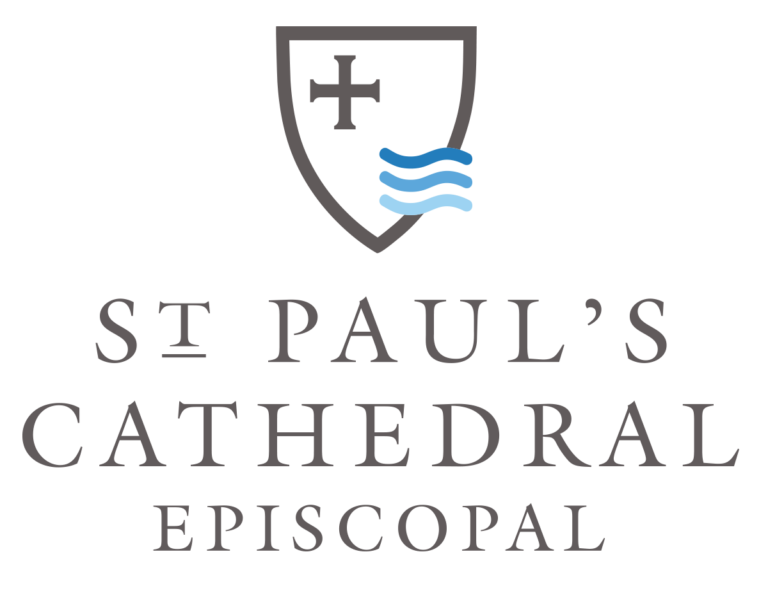Hello St Paul’s,
Anyone who attends an Episcopal Sunday service more than once or twice knows that we have a certain structure to our worship services. The Book of Common Prayer is a great treasure, not least because it provides this structure, so that clergy don’t have to invent the service from whole cloth each week (this happens in some denominations, with very variable results). Our liturgy has been carefully and prayerfully designed, reaching back into some of the earliest documents of the Christian tradition, connecting us with other Anglicans and our ancestors in the faith while providing a tried-and-true format that leads us deep into the mystery of God’s love.
The Eucharist service is in two major parts: the liturgy of the Word, and the liturgy of the Table. After an opening greeting and prayer, we hear the word of God, starting with the ancient Hebrew covenant or Old Testament, then a portion of the book of Psalms that was the response of the ancient Jews to God’s word. Then we move to the New Testament, hearing from a letter or Revelation before culminating in a reading from one of the four Gospels. The Gospel is given special reverence, everyone standing and often a Gospel procession with lights and incense. The sermon is the preacher’s thoughtful and informed response to the Word: it can take the form of words, pictures, dance, or music; it can be a conversation or a monologue.
The portion of the service following the sermon has a modular form: in a regular Eucharist we continue with a statement of the faith we share as articulated in the Nicene Creed (sometimes needed as a corrective to the preacher’s theology!), before offering the prayers of the community for the world, the church, those in need, and those who have died. An alternative “module” for this part of the service involves baptism, with a series of questions for those to be baptized and their sponsors, followed by the congregation’s recitation of the Apostles’ Creed, the blessing of water and the actual baptism.
There are yet other options, including marriage or confirmation, that may occupy this space. We may say a corporate prayer of confession (our practice at St. Paul’s is to omit the confession during the seven weeks of the Easter season). Whatever the content, this part of the service ends with us exchanging the Peace of Christ with one another, an opportunity to offer forgiveness and reconciliation within the congregation before we approach the altar.
The liturgy of the Table follows a standard pattern, within which there are as many as eight options in our prayer book. We begin with a dialogue between presider and people; then the presider prays the Eucharistic Prayer or Great Thanksgiving on the people’s behalf, referring to the Biblical story of salvation and the sacrifice of Christ before blessing the bread and wine. The prayer ends with the Great Amen, which presider and people are expected to say together. We pray the Lord’s Prayer and then the presider breaks the bread, the most solemn moment of the Eucharist, in a mandated moment of silence. After the invitation is given we offer Communion to all who come forward.
The service ends quite briskly once Communion is over, with a prayer that sends us into the world to do the work God has given us to do, an optional blessing of the people, and a dismissal by the Deacon, whose particular responsibility is to assist the people in caring for the needs of the world.
This is the shape of our liturgy, and it follows a pattern that is nearly as old as the Christian faith. Of course we add all kinds of extras, most of them musical. The music in our service can serve various purposes, including bringing us together in congregational song, providing cover for movement, and giving space for meditation and reflection. We use incense in most seasons of the year to deepen our reverence as the smoke carries our prayers to heaven. The practicalities of the service, such as entering and exiting, preparing the table, washing the presider’s hands, or providing light to read by, have all taken on ceremonial significance and acquired theological interpretations over the years. But the essential structure remains, giving us a sense of unity across parishes and through time. The language may have changed, but in our liturgy we are united to the Communion of Saints, that great cloud of witnesses who have worshiped before us in other times and places.
In this season many of us are traveling – I will be out on vacation for the next two Sundays – but we can be confident that if we attend an Episcopal service while we are away, the familiarity of the liturgy will connect us back to this faith community, reminding us that we are all members of the one body of Christ.
See you in a couple of weeks!
Your sister in Christ,
Penny

